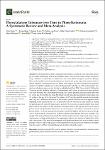Phenylalanine Tolerance over Time in Phenylketonuria: A Systematic Review and Meta-Analysis
| dc.contributor.author | Pinto, A | |
| dc.contributor.author | Ilgaz, F | |
| dc.contributor.author | Evans, S | |
| dc.contributor.author | van Dam, E | |
| dc.contributor.author | Rocha, JC | |
| dc.contributor.author | Karabulut, E | |
| dc.contributor.author | Hickson, M | |
| dc.contributor.author | Daly, A | |
| dc.contributor.author | MacDonald, A | |
| dc.date.accessioned | 2023-09-04T10:28:59Z | |
| dc.date.available | 2023-09-04T10:28:59Z | |
| dc.date.issued | 2023-08-08 | |
| dc.identifier.issn | 2072-6643 | |
| dc.identifier.issn | 2072-6643 | |
| dc.identifier.other | 3506 | |
| dc.identifier.uri | https://pearl.plymouth.ac.uk/handle/10026.1/21280 | |
| dc.description.abstract |
<jats:p>In phenylketonuria (PKU), natural protein tolerance is defined as the maximum natural protein intake maintaining a blood phenylalanine (Phe) concentration within a target therapeutic range. Tolerance is affected by several factors, and it may differ throughout a person’s lifespan. Data on lifelong Phe/natural protein tolerance are limited and mostly reported in studies with low subject numbers. This systematic review aimed to investigate how Phe/natural protein tolerance changes from birth to adulthood in well-controlled patients with PKU on a Phe-restricted diet. Five electronic databases were searched for articles published until July 2020. From a total of 1334 results, 37 articles met the eligibility criteria (n = 2464 patients), and 18 were included in the meta-analysis. The mean Phe (mg/day) and natural protein (g/day) intake gradually increased from birth until 6 y (at the age of 6 months, the mean Phe intake was 267 mg/day, and natural protein intake was 5.4 g/day; at the age of 5 y, the mean Phe intake was 377 mg/day, and the natural protein intake was 8.9 g/day). However, an increase in Phe/natural protein tolerance was more apparent at the beginning of late childhood and was >1.5-fold that of the Phe tolerance in early childhood. During the pubertal growth spurt, the mean natural protein/Phe tolerance was approximately three times higher than in the first year of life, reaching a mean Phe intake of 709 mg/day and a mean natural protein intake of 18 g/day. Post adolescence, a pooled analysis could only be performed for natural protein intake. The mean natural protein tolerance reached its highest (32.4 g/day) point at the age of 17 y and remained consistent (31.6 g/day) in adulthood, but limited data were available. The results of the meta-analysis showed that Phe/natural protein tolerance (expressed as mg or g per day) increases with age, particularly at the beginning of puberty, and reaches its highest level at the end of adolescence. This needs to be interpreted with caution as limited data were available in adult patients. There was also a high degree of heterogeneity between studies due to differences in sample size, the severity of PKU, and target therapeutic levels for blood Phe control.</jats:p> | |
| dc.format.extent | 3506-3506 | |
| dc.format.medium | Electronic | |
| dc.language | en | |
| dc.publisher | MDPI AG | |
| dc.subject | phenylketonuria | |
| dc.subject | PKU | |
| dc.subject | protein | |
| dc.subject | protein tolerance | |
| dc.subject | protein substitute | |
| dc.subject | natural protein | |
| dc.subject | phenylalanine | |
| dc.subject | phenylalanine tolerance | |
| dc.subject | medical formula | |
| dc.subject | amino acids | |
| dc.title | Phenylalanine Tolerance over Time in Phenylketonuria: A Systematic Review and Meta-Analysis | |
| dc.type | journal-article | |
| dc.type | Review | |
| plymouth.author-url | https://www.ncbi.nlm.nih.gov/pubmed/37630696 | |
| plymouth.issue | 16 | |
| plymouth.volume | 15 | |
| plymouth.publisher-url | http://dx.doi.org/10.3390/nu15163506 | |
| plymouth.publication-status | Published online | |
| plymouth.journal | Nutrients | |
| dc.identifier.doi | 10.3390/nu15163506 | |
| plymouth.organisational-group | |Plymouth | |
| plymouth.organisational-group | |Plymouth|Research Groups | |
| plymouth.organisational-group | |Plymouth|Faculty of Health | |
| plymouth.organisational-group | |Plymouth|Faculty of Health|School of Health Professions | |
| plymouth.organisational-group | |Plymouth|Research Groups|Institute of Health and Community | |
| plymouth.organisational-group | |Plymouth|REF 2021 Researchers by UoA | |
| plymouth.organisational-group | |Plymouth|Users by role | |
| plymouth.organisational-group | |Plymouth|Users by role|Academics | |
| plymouth.organisational-group | |Plymouth|REF 2021 Researchers by UoA|UoA03 Allied Health Professions, Dentistry, Nursing and Pharmacy | |
| plymouth.organisational-group | |Plymouth|Research Groups|Plymouth Institute of Health and Care Research (PIHR) | |
| dc.publisher.place | Switzerland | |
| dcterms.dateAccepted | 2023-08-03 | |
| dc.date.updated | 2023-09-04T10:28:34Z | |
| dc.rights.embargodate | 2023-9-5 | |
| dc.identifier.eissn | 2072-6643 | |
| dc.rights.embargoperiod | forever | |
| rioxxterms.versionofrecord | 10.3390/nu15163506 |


